Greenhouse gas emissions 2018: estimates
Estimates of greenhouse gas emissions in Scotland for the years 1990 to 2018.
Section B. Results – Net Sources of Scottish Greenhouse Gas Emissions
2018 results
Chart B1 presents the sources and sinks of Scottish Greenhouse Gas Emissions in 2018, grouped by Grouped by National Communication category.
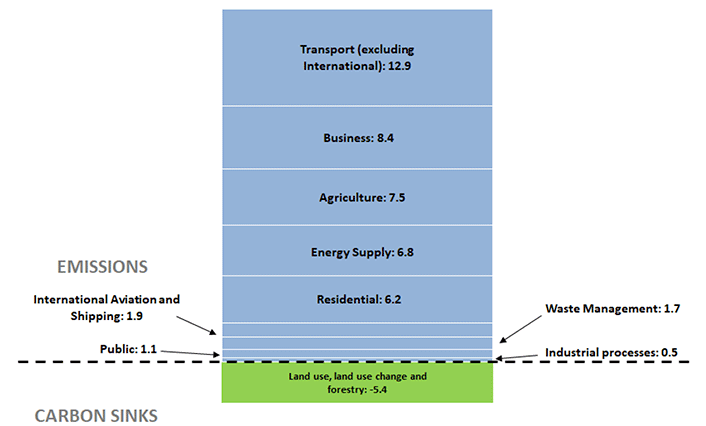
Main points
- In 2018, Transport (excluding International Aviation and Shipping) (12.9 MtCO2e) was the largest source of net emissions, followed by Business (8.4 MtCO2e) and Agriculture (7.5 MtCO2e).
- 'Land use, land use change and forestry' was the only aggregate sector in which there has been a net emissions sink (-5.4 MtCO2e).
|
|
TOTAL | Carbon dioxide | Methane | Nitrous oxide | Fluorinated gases |
|---|---|---|---|---|---|
| TOTAL |
41.6 | 30.9 | 6.3 | 3.2 | 1.2 |
| Transport (excluding international) |
12.9 | 12.8 | 0.0 | 0.1 | 0.0 |
| Business |
8.4 | 7.2 | 0.0 | 0.1 | 1.1 |
| Agriculture |
7.5 | 1.0 | 4.2 | 2.2 | 0.0 |
| Energy Supply |
6.8 | 6.3 | 0.4 | 0.1 | 0.0 |
| Residential |
6.2 | 6.0 | 0.1 | 0.0 | 0.1 |
| International Aviation and Shipping |
1.9 | 1.9 | 0.0 | 0.0 | 0.0 |
| Waste Management |
1.7 | 0.0 | 1.6 | 0.1 | 0.0 |
| Public |
1.1 | 1.1 | 0.0 | 0.0 | 0.0 |
| Industrial processes |
0.5 | 0.5 | 0.0 | 0.0 | 0.0 |
| Land use, land use change and forestry |
-5.4 | -6.0 | 0.0 | 0.5 | 0.0 |
Main points
Carbon dioxide was the main greenhouse gas emitted or removed in most sectors, with the exceptions of the Agriculture and Waste Management sectors.
- Methane was the main net gas emitted in the Agriculture (4.2 MtCO2e), followed by nitrous oxide (2.2 MtCO2e) and carbon dioxide (1.0 MtCO2e).
- Almost all emissions in the Waste Management sector were emitted in the form of methane (1.6 MtCO2e).
Where F gases are emitted, they have been in relatively small amounts via the Business and Residential sectors.
Key Trends By Scottish National Communication Category
Chart B2 presents the main sources of Scottish Greenhouse Gas Emissions from 1990 to 2018, broken down by National Communication categories. Chart B3 and Chart B4 specifically explore the trend in Energy Supply emissions. Chart B5 contains information on the reductions in greenhouse gas emissions in every National Communication category over the entire time period, with Chart B6 containing the same information for the latest year.
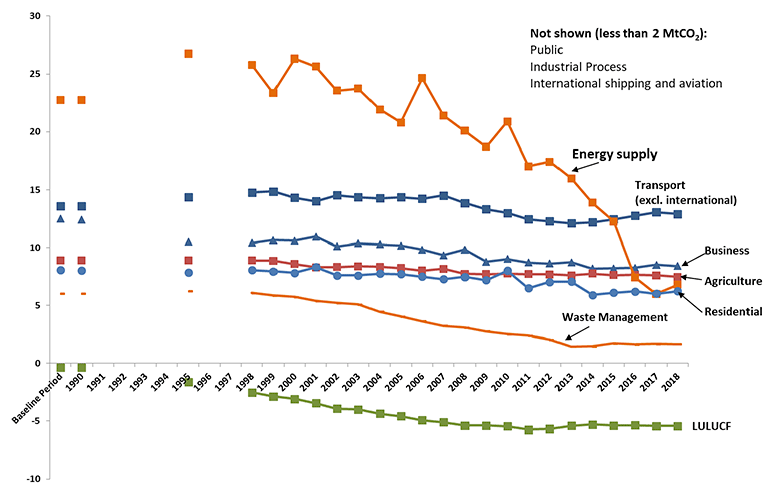
Main Points
Most sectors exhibit a general downwards trend between 1990 and 2018:
- Energy Supply emissions have seen the largest decrease in MtCO2e (-15.9 MtCO2e, a reduction of 70.1 per cent) followed by Waste management (-4.4 MtCO2e, a reduction of 72.2 per cent), and Business (-4.0 MtCO2e, a reduction of 32.2 per cent)
- International Shipping and Aviation emissions have increased (0.6 MtCO2e, a 44.9 per cent increase) over the period
- Scotland's land use is an overall carbon sink. Over the period, the net effect of land use has changed significantly. In 1990 it was a sink for 0.4 MtCO2e, increasing to a sink for 5.4 MtCO2e in 2018
we see an increase in the Energy Supply category for 2018 compared to the previous year. This increase is 0.8 MtCO2e (up 13.4 per cent since 2017). This category is the main driver of change between 2017 and 2018.
Chart B3 shows how the generation of Scotland's electricity has changed over time. Emissions from the electricity supply sector (such as power stations) are associated with these changes.
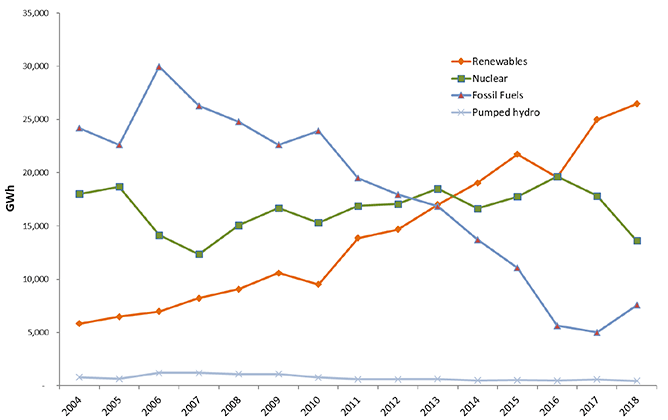
Data obtained from Scottish Energy Statistics Database[4]
Main Points
Overall, the gigawatt-hours of electricity generated in Scotland decreased by 0.5 per cent between 2017 and 2018. Renewables were the single largest source of electricity generated in Scotland in 2018 at 54.9 per cent, followed by nuclear generation at 28.2 per cent with fossil fuel generation making up only 15.7 per cent. However, from 2017 to 2018 fossil fuels use increased by 2.6 Gwh, an increase of 51 per cent.
Long term (1990 to 2018) and short term (2017 to 2018) trends by category
Chart B4 shows how emissions have changed between 1990 and 2018 in all source categories. Chart B5 shows how emissions have changed between 2017 and 2018.
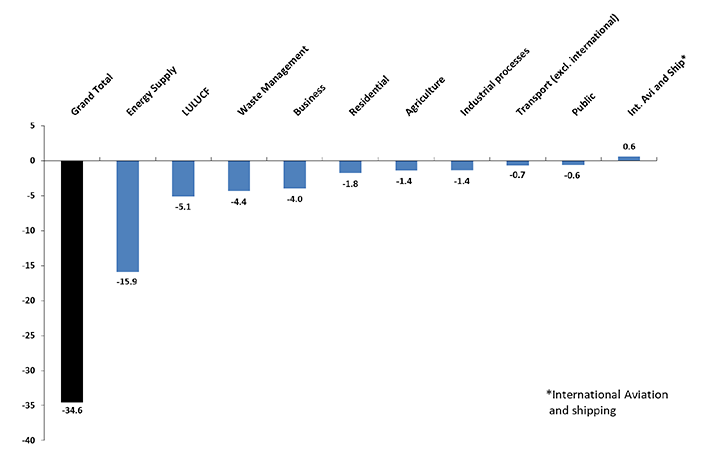
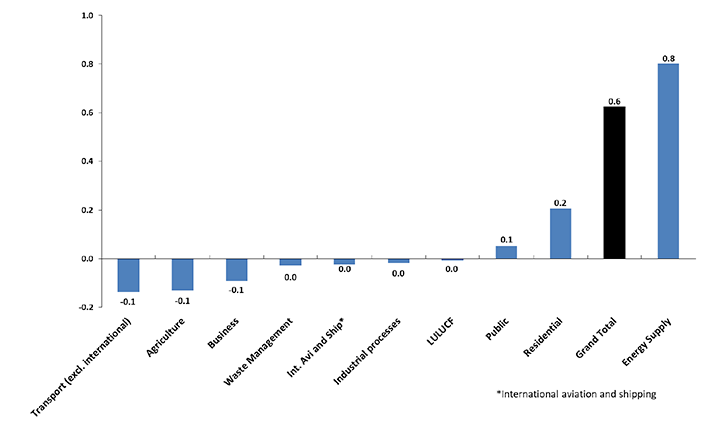
Total Emissions
Overall, there has been a 34.6 MtCO2e (45.4 per cent) decrease in net emissions between 1990 and 2018. However, there has been a 0.6 MtCO2e (1.5 per cent) increase in net emissions between 2017 and 2018.
Land use, land use change and forestry (LULUCF)
LULUCF is a net sink of emissions for Scotland, offsetting 5.4 MtCO2e of emissions in 2018. In 1990 the offset was only 0.4 MtCO2e. The offset has been fairly stable over the last 4 years.
Although LULUCF is a net sink, it has factors that both emit and offset CO2e. In 2018 it emitted 7.6 MtCO2e, but offset 13.1 MtCO2e (making it a net sink of 5.4 MtCO2e). The main sources of emissions is land used for cropland and settlements. The main sinks are Forestry, grassland and carbon stored in wood products.
Transport (excluding International)
Transport has consistently been a large part of Scotland's emissions, with a decrease of only 4.9 per cent between 1990 (13.6 MtCO2e) and 2018 (12.9 MtCO2e). Historically it was second only to Energy supply, however the decline in Energy supply emissions has left transport as the leading emitter since 2015.
Transport emissions have decreased by 0.1 MtCO2e (1.1 per cent reduction) between 2017 and 2018.
Energy Supply
Energy Supply was historically the biggest contribution to emissions, but has seen large changes over the period, reducing from 22.7 MtCO2e in 1990 to 6.8 MtCO2e in 2018 ( 70.1 per cent reduction). Overall Emissions reductions in this sector are mainly due to reductions in emissions from power stations and the complete cessation of coal use in electricity generation in Scotland.
Between 2017 and 2018 Energy Supply emissions increased by 0.8 MtCO2e (13.4 per cent increase). This increase was driven by an increase in CO2 emissions from power stations. Chart B3 shows the increase in fossil fuel use for power generation in 2018. This increase was primarily from a major power station, which approximately doubled its CO2 output between 2017 and 2018.
Despite the most recent years trend, reduction in power station emissions is still one of the most substantial changes in Scotland's emissions since 1990; changes in Energy Supply alone accounts for 46 per cent of the decline in Scotland emissions since the base year. Emissions from public electric (and heat) generation have reduced by 85 per cent between 1990 and 2018, due primarily to the shift in fuel mix from coal to less carbon intensive fuels, including increased use of nuclear and renewables.
Business
This sector has seen a 4.0 MtCO2e (32.2 per cent) fall in emissions between 1990 and 2018. As shown in Chart B2, much of this decrease occurred between 1990 and 1995 – linked to a decline in emissions from manufacturing and the iron and steel industry over this time period. There has been a further smaller decrease between 2008 and 2009 (1.0 MtCO2e decrease) , coinciding with the recession. Between 2017 and 2018 there was a small 0.1 MtCO2e decrease.
Agriculture
This sector has seen a 1.4 MtCO2e (15.9 per cent) fall in net emissions between 1990 and 2018. Between 2017 and 2018, there was a 0.1 MtCO2e (1.7 per cent) decrease in net emissions of overall greenhouse gases from this sector.
Residential
The residential sector is dominated by direct fuel combustion in households. There has been a decrease of 22.2 per cent between 1990 and 2018. This long-term decrease is mainly due to a switch from less efficient solid and liquid fuels to natural gas for heating, and improvements in energy efficiency.
Residential emissions have increased slightly between 2017 and 2018 from 6.0 MtCO2e to 6.2 MtCO2e (3.4 per cent). This increase was possibly driven by a colder winter in 2018 compared to 2017, resulting in more fuel burnt for domestic heating (Chart B6).
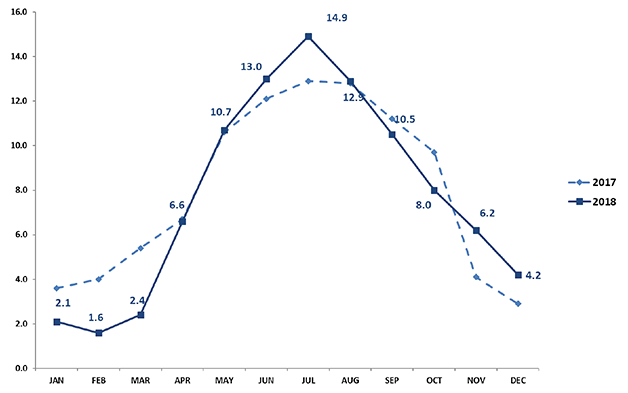
Data obtained from Met Office[5]
International Aviation and shipping
International aviation has increased by 0.6 MtCO2e (44.9 per cent) from 1990 to 2018. There was little change between 2017 and 2018, with the value remaining at 1.9 MtCO2e. The increase is driven by international aviation, which emissions almost tripled from 1990 to 2018 (up 186 per cent). In contrast shipping emissions have halved over the same period (down 56 per cent).
Waste Management
Waste management emissions tend to be dominated by methane emissions. Emissions from Waste Management have been relatively static over the last couple of year, with a value of 1.7 MtCO2e for 2018. However, between 1990 and 2018 emissions reduced by 4.4 MtCO2e (72.2 per cent). This decrease is largely due to the progressive introduction of methane capture and oxidation systems within landfill management.
Public
The main source of emissions from this sector is the use of natural gas for heating public buildings. There was a 0.6 MtCO2e (34.8 per cent) fall in emissions from public sector buildings between 1990 and 2018. Emissions over the last few years have been relatively stable, with a value of 1.1 MtCO2e in 2018.
Industrial Processes
This sector has seen a 1.4 MtCO2e (72.1 per cent) decrease from 1990 to 2018. Values have been relatively stable over the last couple of decades, with 2018 having a value of 0.5 MtCO2e. Most of the decrease in the sector happened between 1990 and 1995, and was associated with decreased emissions in the Nitric acid production industry and from a process known as sintering – a process that used to be associated with the iron and steel industry.
Emissions by type of gas
Chart B7 shows the trends in emissions, broken down by gas from 1990 to 2018.
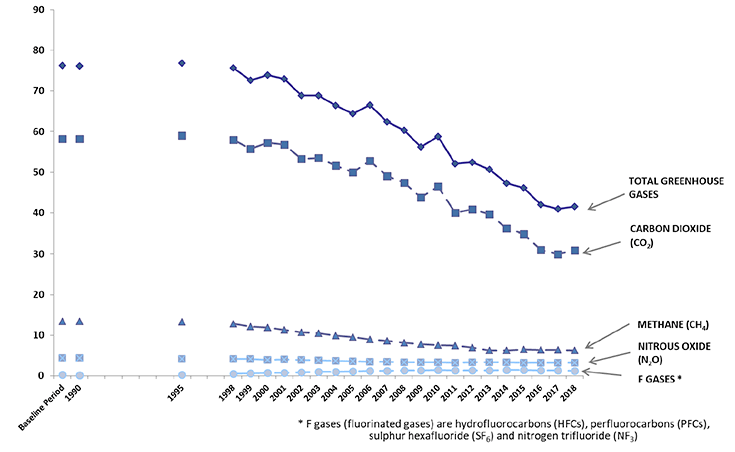
Main Points
- Carbon dioxide is by far the largest contributor to Scottish greenhouse gas emissions in all years (74.2 per cent of all emissions in 2018) and is the most volatile series of all gases – largely driven by changes in energy supply emissions and to a lesser extent, emissions from the residential and business categories.
- Methane is the second most common greenhouse gas in 2018 (15.1 per cent of all net emissions) followed by nitrous oxide (7.7 per cent) and F-gases making up the remainder (3.0 per cent).
- Carbon dioxide has seen the largest reduction from 1990 to 2018 (27.3 MtCO2e reduction). There have also been reductions in both methane (7.1 MtCO2e reduction) and nitrous oxide (1.2 MtCO2e reduction). Emissions from fluorinated gases have shown a large increase from 1990 to 2018, although they still remain small in absolute terms, driven by the introduction of hydrofluourocarbons (HFCs) from 1995 onwards. These HFCs replace chlorofluorocarbons (CFCs) which were banned by the Montreal Protocol due to their impact on the ozone layer.
Charts B8 to B11 present results on individual gases broken down by main National Communication categories over time. Chart B8 shows how carbon dioxide emissions have changed from 1990 to 2018.
Carbon Dioxide (CO2)
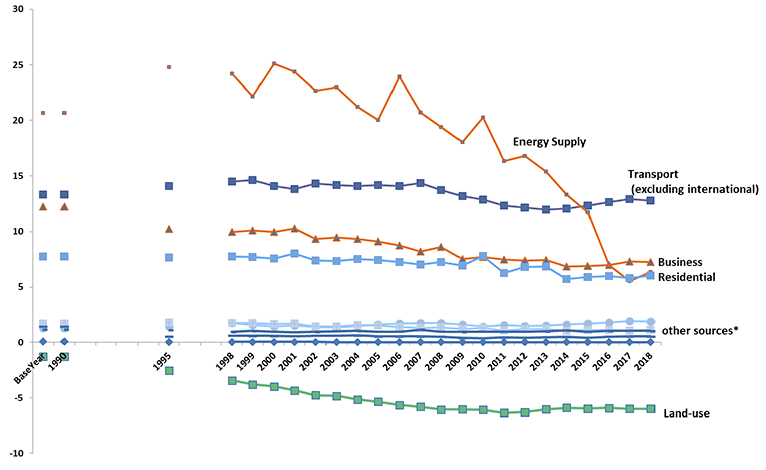
Main Points
- Chart B8 shows that Energy Supply is a key source of carbon dioxide emissions in all years between 1990 and 2015, after which the change in fuels used in electricity generation substantially reduces CO2 emissions from this source. Change in energy supply emissions is the main driver of changes in total carbon dioxide emissions. Emissions from this category have been volatile, with the highest emissions occurring between 1995 and 2003, and a spike in 2006, related to a greater use of coal in that year.
- Transport (excluding international) is the next most common source of carbon dioxide emissions across the entire time-series. In 2015 Transport became the highest source of emissions for the first time in the time series.
- Land use has become a much greater net sink for Scotland over the period. In 1990 it offset 1.3 MtCO2e of emissions, by 2018 it offset 6.0 MtCO2e of emissions. The largest increases in the sink have been related to forestry and the conversion of grassland to cropland.
Methane (CH4)
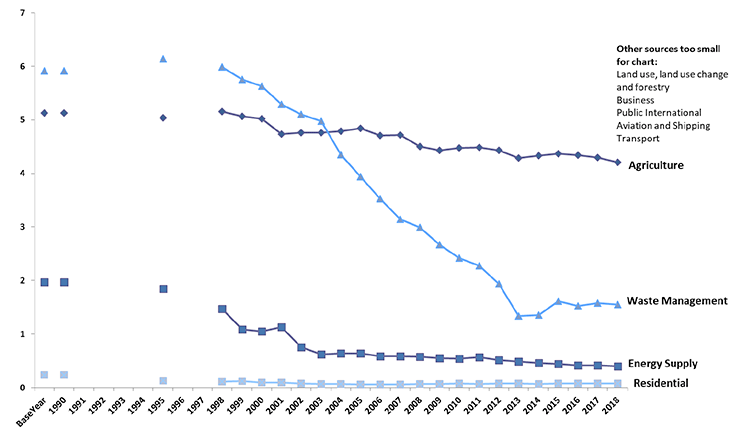
Main Points
- Methane emissions from waste management have fallen by 4.4 MtCO2e between 1990 and 2018 (a 73.7 per cent reduction). This is largely due to the progressive introduction of methane capture and oxidation systems within landfill management.
- Methane emissions in the agriculture sector have fallen by 0.9 MtCO2e between 1990 and 2018 (an 18.0 per cent reduction). This is mainly due to a decrease in livestock numbers (particularly cattle and sheep).
- In the Energy Supply sector, methane emissions have fallen by 1.6 MtCO2e between 1990 and 2018 (a 79.6 per cent reduction), partly due to reductions in emissions from sources such as coal mining.
Nitrous Oxide (N2O)
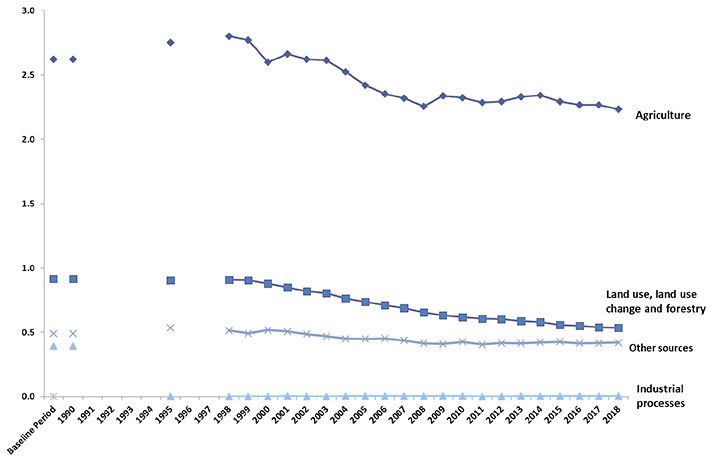
Main Points
- Agriculture is by far the main contributor to emissions of nitrous oxide. These are largely produced by agricultural practices on soils, and to a lesser extent by animal manures. Emissions of nitrous oxide in this sector have fallen by 0.4 MtCO2e between 1990 and 2018 – A 14.8 per cent reduction.
- 'Land use, land use change and forestry' fell by 0.4 MtCO2e (41.6 per cent reduction) over the same period. Of the 0.5 MtCO2e emitted in 2018 0.2 MtCO2e is associated with agriculture.
- Emissions of nitrous oxide from Industrial processes have fallen from 0.4 MtCO2e in 1990 to 0.003 MtCO2e in 2018.
Fluorinated gases (F-gases)
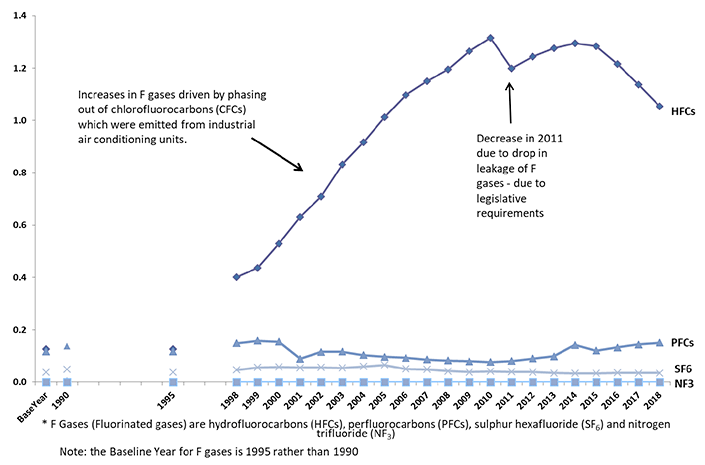
Main Points
- F gases are the most potent greenhouse gases with high global warming potentials but they are emitted in very small quantities. As a result, they contribute less to global warming than the other greenhouse gases in Scotland. (For targets these gases use 1995 as a baseline year rather than 1990)
- There is a sharp increase in HFC gases of 0.9 MtCO2e between 1995 and 2018 (from 0.1 MtCO2e in 1995 to 1.1 MtCO2e in 2018). This change is almost entirely in the Business sector. This increase is because F gases were introduced to replace chlorofluorocarbons (CFCs), which were used in appliances such as industrial air conditioning units. CFCs were banned under the Montreal Protocol, as they were contributing to the depletion of the ozone layer.
- F gas emissions in the residential sector result from the use of aerosols and asthma inhalers, and represent around 0.1 MtCO2e in 2018.
| Source Sector |
Baseline Period | 1990 | 1995 | 1998 | 2000 | 2002 | 2004 | 2006 | 2008 | 2009 | 2010 | 2011 | 2012 | 2013 | 2014 | 2015 | 2016 | 2017 | 2018 | Change 1990 to 2018 | % change 1990 to 2018 | Change 2017 to 2018 | % change 2017 to 2018 |
|---|---|---|---|---|---|---|---|---|---|---|---|---|---|---|---|---|---|---|---|---|---|---|---|
| Grand Total |
76.3 | 76.2 | 76.8 | 75.6 | 73.9 | 68.8 | 66.4 | 66.6 | 60.3 | 56.3 | 58.9 | 52.1 | 52.5 | 50.8 | 47.3 | 46.2 | 42.0 | 41.0 | 41.6 | -34.6 | -45.4% | 0.6 | 1.5% |
| Transport (excluding international) |
13.6 | 13.6 | 14.4 | 14.8 | 14.3 | 14.5 | 14.3 | 14.2 | 13.9 | 13.3 | 13.0 | 12.4 | 12.3 | 12.1 | 12.2 | 12.4 | 12.8 | 13.0 | 12.9 | -0.7 | -4.9% | -0.1 | -1.1% |
| Business |
12.5 | 12.4 | 10.5 | 10.4 | 10.6 | 10.1 | 10.3 | 9.8 | 9.8 | 8.8 | 9.0 | 8.7 | 8.6 | 8.7 | 8.2 | 8.2 | 8.2 | 8.5 | 8.4 | -4.0 | -32.2% | -0.1 | -1.1% |
| Agriculture |
8.9 | 8.9 | 8.9 | 8.9 | 8.6 | 8.3 | 8.3 | 8.0 | 7.7 | 7.7 | 7.7 | 7.7 | 7.7 | 7.6 | 7.7 | 7.6 | 7.6 | 7.6 | 7.5 | -1.4 | -15.9% | -0.1 | -1.7% |
| Energy Supply |
22.7 | 22.7 | 26.7 | 25.8 | 26.3 | 23.6 | 21.9 | 24.6 | 20.1 | 18.7 | 20.9 | 17.0 | 17.4 | 16.0 | 13.9 | 12.2 | 7.4 | 6.0 | 6.8 | -15.9 | -70.1% | 0.8 | 13.4% |
| Residential |
8.1 | 8.0 | 7.8 | 8.1 | 7.8 | 7.6 | 7.8 | 7.5 | 7.5 | 7.2 | 8.0 | 6.5 | 7.0 | 7.1 | 5.9 | 6.1 | 6.2 | 6.0 | 6.2 | -1.8 | -22.2% | 0.2 | 3.4% |
| International Aviation and Shipping |
1.3 | 1.3 | 1.5 | 1.7 | 1.4 | 1.4 | 1.5 | 1.7 | 1.8 | 1.6 | 1.4 | 1.6 | 1.5 | 1.5 | 1.6 | 1.7 | 1.8 | 1.9 | 1.9 | 0.6 | 44.9% | 0.0 | -1.3% |
| Waste Management |
6.0 | 6.0 | 6.2 | 6.1 | 5.7 | 5.2 | 4.5 | 3.6 | 3.1 | 2.8 | 2.5 | 2.4 | 2.0 | 1.5 | 1.5 | 1.7 | 1.6 | 1.7 | 1.7 | -4.4 | -72.2% | 0.0 | -1.7% |
| Public |
1.7 | 1.7 | 1.8 | 1.8 | 1.6 | 1.4 | 1.6 | 1.4 | 1.3 | 1.2 | 1.3 | 1.1 | 1.2 | 1.2 | 1.0 | 1.1 | 1.1 | 1.0 | 1.1 | -0.6 | -34.8% | 0.1 | 5.0% |
| Industrial processes |
1.9 | 1.9 | 0.6 | 0.6 | 0.6 | 0.6 | 0.6 | 0.6 | 0.5 | 0.4 | 0.4 | 0.5 | 0.4 | 0.5 | 0.5 | 0.4 | 0.5 | 0.6 | 0.5 | -1.4 | -72.1% | 0.0 | -3.1% |
| Land use, land use change and forestry |
-0.4 | -0.4 | -1.6 | -2.5 | -3.1 | -3.9 | -4.4 | -4.9 | -5.4 | -5.4 | -5.4 | -5.7 | -5.7 | -5.4 | -5.3 | -5.4 | -5.4 | -5.4 | -5.4 | -5.1 | 1435% | 0.0 | 0.1% |
(some early years omitted to fit table on page, full table available in the accompanying excel tables file)
| Baseline Period | 1990 | 1995 | 1998 | 2000 | 2002 | 2004 | 2006 | 2008 | 2010 | 2011 | 2012 | 2013 | 2014 | 2015 | 2016 | 2017 | 2018 | 1990 to 2018 | % 1990 to 2018 | 2017 to 2018 | % 2017 to 2018 | % Share of GHG 2018 | |
|---|---|---|---|---|---|---|---|---|---|---|---|---|---|---|---|---|---|---|---|---|---|---|---|
| Total Greenhouse Gases |
76.3 | 76.2 | 76.8 | 75.6 | 73.9 | 68.8 | 66.4 | 66.6 | 60.3 | 58.9 | 52.1 | 52.5 | 50.8 | 47.3 | 46.2 | 42.0 | 41.0 | 41.6 | -34.6 | -45% | 0.6 | 1.5% | 100.0% |
| Carbon dioxide (CO2) |
58.2 | 58.2 | 59.1 | 58.0 | 57.3 | 53.2 | 51.6 | 52.9 | 47.5 | 46.5 | 40.1 | 40.8 | 39.8 | 36.2 | 34.9 | 31.0 | 30.0 | 30.9 | -27.3 | -47% | 0.9 | 2.9% | 74.2% |
| Methane (CH4) |
13.4 | 13.4 | 13.3 | 12.8 | 11.9 | 10.8 | 9.9 | 9.0 | 8.2 | 7.6 | 7.4 | 7.0 | 6.3 | 6.3 | 6.5 | 6.4 | 6.4 | 6.3 | -7.1 | -53% | -0.1 | -2.1% | 15.1% |
| Nitrous oxide (N2O) |
4.4 | 4.4 | 4.2 | 4.2 | 4.0 | 3.9 | 3.7 | 3.5 | 3.3 | 3.4 | 3.3 | 3.3 | 3.3 | 3.3 | 3.3 | 3.2 | 3.2 | 3.2 | -1.2 | -28% | 0.0 | -1.1% | 7.7% |
| * F gases |
0.3 | 0.2 | 0.3 | 0.6 | 0.7 | 0.9 | 1.1 | 1.2 | 1.3 | 1.4 | 1.3 | 1.4 | 1.4 | 1.5 | 1.4 | 1.4 | 1.3 | 1.2 | 1.1 | 560% | -0.1 | -5.8% | 3.0% |
| of which HFCs |
0.1 | 0.0 | 0.1 | 0.4 | 0.5 | 0.7 | 0.9 | 1.1 | 1.2 | 1.3 | 1.2 | 1.2 | 1.3 | 1.3 | 1.3 | 1.2 | 1.1 | 1.1 | 1.1 | 49423% | -0.1 | -7.4% | 2.5% |
| PFCs |
0.1 | 0.1 | 0.1 | 0.1 | 0.2 | 0.1 | 0.1 | 0.1 | 0.1 | 0.1 | 0.1 | 0.1 | 0.1 | 0.1 | 0.1 | 0.1 | 0.1 | 0.2 | 0.0 | 10% | 0.0 | 4.8% | 0.4% |
| SF6 |
0.0 | 0.0 | 0.0 | 0.0 | 0.1 | 0.1 | 0.1 | 0.1 | 0.0 | 0.0 | 0.0 | 0.0 | 0.0 | 0.0 | 0.0 | 0.0 | 0.0 | 0.0 | 0.0 | -28% | 0.0 | 0.1% | 0.1% |
| NF3 |
0.0 | 0.0 | 0.0 | 0.0 | 0.0 | 0.0 | 0.0 | 0.0 | 0.0 | 0.0 | 0.0 | 0.0 | 0.0 | 0.0 | 0.0 | 0.0 | 0.0 | 0.0 | 0.0 | 101% | 0.0 | 10.0% | 0.0% |
(some early years omitted to fit table on page, full table available in the accompanying excel tables file)
Contact
Email: Andrew.Mortimer@gov.scot
There is a problem
Thanks for your feedback